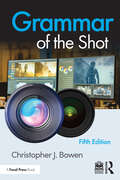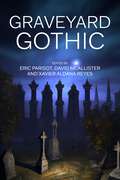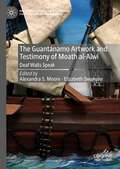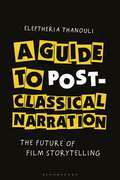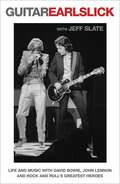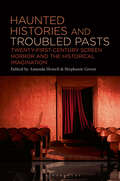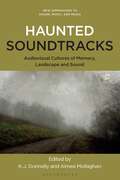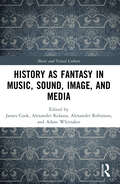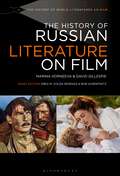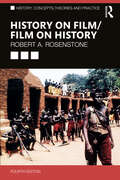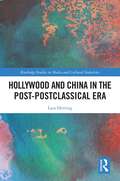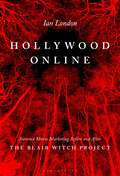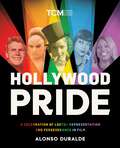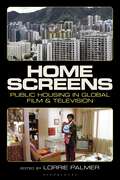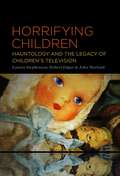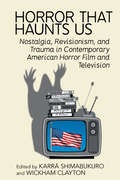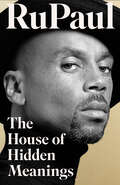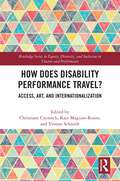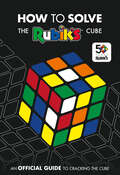- Table View
- List View
Grammar of the Shot
by Christopher J. BowenThe newly revised and updated fifth edition of Grammar of the Shot teaches readers theoretical principles behind successful visual communication in motion media through discussions of shot composition, depth cues, lens choices, lighting, screen direction, camera movement, and shooting for editing. Many general practices are outlined that will help readers create rich, multi-layered visuals. Designed as an easy-to-use reference, this book presents each topic succinctly with clear photographs and diagrams illustrating key concepts, practical exercises, and quiz questions, and is a staple of any filmmaker’s library. New to the fifth edition: Instructional and student resources offer downloadable and editable raw footage so that students can practice the techniques described in the book, and instructional videos showcasing examples of different editing choices and types of shot transitions. Thorough chapter content reviews and refreshed exercises and quizzes help test readers on their knowledge using real-world scenarios. New sections, Principles in Practice (PIPs), concludes each chapter by presenting unique scenarios that a video maker may encounter in their own video-editing work and offers creative solutions and advice on how one might handle them. Together with its companion volume, Grammar of the Edit, the core concepts discussed in these books offer concise and practical resources for both experienced and aspiring filmmakers.
Graveyard Gothic
by Eric Parisot, David McAllister and Xavier Aldana ReyesGraveyard Gothic is the first sustained consideration of the graveyard as a key Gothic locale. This volume examines various iterations of the Gothic graveyard (and other burial sites) from the eighteenth century to the twenty-first, as expressed in numerous forms of culture and media including poetry, fiction, TV, film and video games. The volume also extends its geographic scope beyond British traditions to accommodate multiple cultural perspectives, including those from the US, Mexico, Japan, Australia, India and Eastern Europe. The seventeen chapters from key international Gothic scholars engage a range of theoretical frameworks, including the historical, material, colonial, political and religious. With a critical introduction offering a platform for further scholarship and a coda mapping potential future critical and cultural developments, Graveyard Gothic is a landmark volume defining a new area of Gothic studies.
Graveyard Gothic
by Eric Parisot David McAllister Xavier Aldana ReyesGraveyard Gothic is the first sustained consideration of the graveyard as a key Gothic locale. This volume examines various iterations of the Gothic graveyard (and other burial sites) from the eighteenth century to the twenty-first, as expressed in numerous forms of culture and media including poetry, fiction, TV, film and video games. The volume also extends its geographic scope beyond British traditions to accommodate multiple cultural perspectives, including those from the US, Mexico, Japan, Australia, India and Eastern Europe. The seventeen chapters from key international Gothic scholars engage a range of theoretical frameworks, including the historical, material, colonial, political and religious. With a critical introduction offering a platform for further scholarship and a coda mapping potential future critical and cultural developments, Graveyard Gothic is a landmark volume defining a new area of Gothic studies.
The Guantánamo Artwork and Testimony of Moath Al-Alwi: Deaf Walls Speak (Palgrave Studies in Literature, Culture and Human Rights)
by Alexandra S. Moore Elizabeth SwansonDeaf Walls Speak presents an insider’s view of artmaking in Guantánamo, the world’s most notorious prison, as self-expression and protest, and to stage a fundamental human rights claim that has been denied by law and politics: the right to be recognized as human. The book juxtaposes detainee artist Moath al-Alwi’s testimony and artwork with essays that situate his work within legal, political, aesthetic, and material contexts to demonstrate that artwork at Guantánamo constitutes important forms of material witnessing to human rights abuses perpetrated and denied by the U.S. government.
Gudetama Cross-Stitch: 30 Easy-to-Follow Patterns from Your Favorite Lazy Egg
by Sosae Caetano Dennis CaetanoGudetama Cross-Stitch combines cross-stitching fun with 30 easy-to-follow patterns inspired by everyone's favorite lazy egg with the can't-be-bothered attitude. Gudetama&’s name literally translates to &“lazy egg,&” and it&’s how we all feel sometimes when it comes to, well, pretty much anything. But if you&’re the kind of person who doesn&’t have time for complicated crafts or dealing with other people, then this collection of 30 Gudetama-inspired designs are just for you. First, you&’ll learn cross-stitching basics including tools and techniques and how to read a cross-stitch chart. Then you&’ll apply your new skills to a range of hilarious and lovable patterns organized into chapters like Lazy, Medium-Lazy, and Pay Attention—depending on how sluggish or motivated you&’re feeling. Finally, you&’ll be able to apply your masterpieces to projects like gift tags, greeting cards, and ornaments. Whether you&’re an experienced cross-stitcher or new to the craft, you&’ll find a variety of poses and patterns in this book that are accessible and easy to learn. With a little patience and practice, anyone can bring these Gudetama-inspired masterpieces to life. And if not, just take a nap.
A Guide to Post-classical Narration: The Future of Film Storytelling
by Dr. Eleftheria ThanouliIn A Guide to Post-classical Narration, Eleftheria Thanouli expands and substantially develops the innovative theoretical work of her previous publication, Post-classical Cinema: an International Poetics of Film Narration (2009). A Guide to Post-classical Narration: The Future of Film Storytelling presents a concise and comprehensive overview of the creative norms of the post-classical mode of narration. With dozens of cases studies and hundreds of color stills from films across the globe, this book provides the definitive account of post-classical storytelling and its techniques. After surfacing in auteur films in varied production milieus in the 1990s, the post-classical options continued to gain ground throughout the 2000s and 2010s, gradually fertilizing several mainstream productions in Hollywood. From Lars von Trier's Europa (1991) to Zack Snyder's Army of the Dead (2021) and Baz Luhrmann's Elvis (2022), the post-classical narration has shown not only impressive resilience but also tremendous creativity in transforming its key formal principles, such as fragmented and multi-thread plotlines, hypermediated realism, parody, graphic frame construction, complex chronology, and intense self-consciousness. Through the meticulous textual analysis of the post-classical works, Eleftheria Thanouli addresses head-on a series of methodological questions in narrative research and brings the tradition of historical poetics back into the limelight. By reinforcing her previous work with numerous new films as well as more nuanced narrative terms and concepts, she not only strengthens her position on post-classical cinema but also establishes the relevance of formalist analysis in the study of film today.
Guitar: A rock 'n' roll tell-all autobiography from David Bowie's sideman
by Jeff Slate Earl SlickRead this rollicking rock 'n' roll memoir of the last 50 years of rock history, from David Bowie's longest serving lead guitarist and legendary sideman, Earl Slick. He's played with everyone from John Lennon to the New York Dolls – and he's got the stories to prove it.----‘Earl is a legendary guitar star. His playing is earth, timeless and never less than stellar’ DAVID BOWIE ‘You play mean ass blues for a skinny ass white boy’ BUDDY GUY ‘Had a good night out did we . . .?’ JOHN LENNON Earl Slick was barely out of his teens when David Bowie hired him to play guitar on the ground-breaking 1974 Diamond Dogs tour. It marked the beginning of a relationship that would endure through thick and thin for the next forty years. Gracing classic albums like Young Americans, Station to Station and the 2013 comeback, The Next Day, Slick played on the tour that followed Bowie’s smash hit Let’s Dance album and was at his side for the epic Glastonbury show in 2000. But it wasn’t just Bowie. The young guitarist was in John Lennon’s band at the time of the former Beatle’s tragic murder. Other collaborations read like a roll call of rock ‘n’ roll royalty including Mick Jagger, The Cure, George Harrison, Ringo Starr, Joe Cocker, Buddy Guy, Ian Hunter, David Coverdale and Eric Clapton. And in the ‘80s he became an MTV star in his own right with the success of Phantom, Rocker and Slick. Through it all he lived the rock ‘n’ roll life to the hilt. Until it nearly killed him. One of rock’s great sidemen, Earl Slick was in the room when music history was made. Guitar takes us there, shining a light on superstars like Bowie and Lennon, while recounting the extraordinary story of the boy from New York City who became a real-life Johnny B. Goode.
Haunted Histories and Troubled Pasts: Twenty-First-Century Screen Horror and the Historical Imagination
by Amanda Howell and Stephanie GreenHaunted Histories and Troubled Pasts speaks to how a transnational array of recent screen entertainments participate, through horror, in public discourses of history, the social and creative work of reshaping popular understanding of our world through the lens of the past.Contemporary film and television – and popular screen cultures more generally – are distinguished by their many and varied engagements with history, including participation in worldwide movements to reconcile past losses and injuries with present legacies. The chapters in this collection address themselves to 21st-century screen horror's participation in this widespread fascination with and concern for the historical - its recurrent reimagining of the relation between the past and present, which is part of its inheritance from the Gothic. They are concerned with the historical work of horror's spectral occupations, its visceral threats of violence and its capacity for exploring repressed social identities, as well as the ruptures and impositions of colonization and nationhood.Trauma is a key theme in this book, examined through themes of war and genocide, ghostly invasions, institutionalized abuse, apocalyptic threat and environmental destruction. These persistent, fearful reimaginings of the past can take many lurid – sometimes tritely generic – forms. Together, these chapters explore and reflect upon horror's ability to speak through them to the unspoken of history, to push the boundaries and probe the fault-lines and ideological impositions of received historical narratives – while reminding us that history and the historical imagination persist as sites of contention.
Haunted Soundtracks: Audiovisual Cultures of Memory, Landscape, and Sound (New Approaches to Sound, Music, and Media)
by K. J. Donnelly and Aimee MollaghanThe turn of the millennium has heralded an outgrowth of culture that demonstrates an awareness of the ephemeral nature of history and the complexity underpinning the relationship between location and the past. This has been especially apparent in the shifting relationship between landscape, memory and sound in film, television and other media. The result is growing interest in soundtracks, as part of audiovisual culture, as well as an interest in the spectral aspects of culture more generally. This collection of essays focuses on audiovisual forms that foreground landscape, sound and memory. The scope of inquiry emphasises the ghostly qualities of a certain body of soundtracks, extending beyond merely the idea of 'scary films' or 'haunted houses.' Rather, the notion of sonic haunting is tied to ideas of trauma, anxiety or nostalgia associated with spatial and temporal dislocation in contemporary society. Touchstones for the approach are the concepts of psychogeography and hauntology, pervasive and established critical strategies that are interrogated and refined in relation to the reification of the spectral within the soundtracks under consideration here.
History as Fantasy in Music, Sound, Image, and Media (Music and Visual Culture)
by James Cook Alexander Kolassa Alexander Robinson Adam WhittakerExploring how music is used to portray the past in a variety of media, this book probes the relationship between history and fantasy in the imagination of the musical past. The volume brings together essays from multidisciplinary perspectives, addressing the use of music to convey a sense of the past in a wide range of multimedia contexts, including television, documentaries, opera, musical theatre, contemporary and historical film, videogames, and virtual reality. With a focus on early music and medievalism, the contributors theorise the role of music and sound in constructing ideas of the past. In three interrelated sections, the chapters problematise notions of historical authenticity on the stage and screen; theorise the future of musical histories in immersive and virtual media; and explore sound’s role in more fantastical appropriations of history in television and videogames. Together, they poseprovocative questions regarding our perceptions of ‘early’ music and the sensory experience of distant history. Offering new ways to understand the past at the crossroads of musical and visual culture, this collection is relevant to researchers across music, media, and historical and cultural studies.
History as Fantasy in Music, Sound, Image, and Media (Music and Visual Culture)
by James Cook, Alexander Kolassa, Alexander Robinson, and Adam WhittakerExploring how music is used to portray the past in a variety of media, this book probes the relationship between history and fantasy in the imagination of the musical past. The volume brings together essays from multidisciplinary perspectives, addressing the use of music to convey a sense of the past in a wide range of multimedia contexts, including television, documentaries, opera, musical theatre, contemporary and historical film, videogames, and virtual reality. With a focus on early music and medievalism, the contributors theorise the role of music and sound in constructing ideas of the past. In three interrelated sections, the chapters problematise notions of historical authenticity on the stage and screen; theorise the future of musical histories in immersive and virtual media; and explore sound’s role in more fantastical appropriations of history in television and videogames. Together, they poseprovocative questions regarding our perceptions of ‘early’ music and the sensory experience of distant history. Offering new ways to understand the past at the crossroads of musical and visual culture, this collection is relevant to researchers across music, media, and historical and cultural studies.
The History of Russian Literature on Film (The History of World Literatures on Film)
by Marina Korneeva David GillespieUnlike most previous studies of literature and film, which tend to privilege particular authors, texts, or literary periods, David Gillespie and Marina Korneeva consider the multiple functions of filmed Russian literature as a cinematic subject in its own right-one reflecting the specific political and aesthetic priorities of different national and historical cinemas. In this first and only comprehensive study of cinema's various engagements of Russian literature focusing on the large period 1895-2015, The History of Russian Literature on Film highlights the ways these adaptations emerged from and continue to shape the social, artistic, and commercial aspects of film history.
History on Film/Film on History (History: Concepts,Theories and Practice)
by Robert A. RosenstoneHistory on Film/Film on History has established itself as a classic treatise on the historical film and its role in bringing the past to life. In the fourth edition of this widely acclaimed text, Robert A. Rosenstone argues that to leave history films out of the discussion of the meaning of the past is to ignore a major means of understanding historical events. This book examines what history films convey about the past and how they convey it, demonstrating the need to learn how to read and understand this new visual world and integrating detailed analysis of films such as Schindler’s List, Glory, October, and Reds. Advocating for the dramatic feature as a legitimate way of doing history, this edition includes a new Preface and a new chapter that focuses on films produced in Latin America, Africa, the Middle East, India, and East Asia. Examining the codes and conventions of how these films tell us about the past and providing guidance on how to effectively analyse films as historical interpretations, this book is an essential introduction to the field for students of history and film.
History on Film/Film on History (History: Concepts,Theories and Practice)
by Robert A. RosenstoneHistory on Film/Film on History has established itself as a classic treatise on the historical film and its role in bringing the past to life. In the fourth edition of this widely acclaimed text, Robert A. Rosenstone argues that to leave history films out of the discussion of the meaning of the past is to ignore a major means of understanding historical events. This book examines what history films convey about the past and how they convey it, demonstrating the need to learn how to read and understand this new visual world and integrating detailed analysis of films such as Schindler’s List, Glory, October, and Reds. Advocating for the dramatic feature as a legitimate way of doing history, this edition includes a new Preface and a new chapter that focuses on films produced in Latin America, Africa, the Middle East, India, and East Asia. Examining the codes and conventions of how these films tell us about the past and providing guidance on how to effectively analyse films as historical interpretations, this book is an essential introduction to the field for students of history and film.
Hollywood and China in the Post-postclassical Era (Routledge Studies in Media and Cultural Industries)
by Lara HerringThis book examines the contemporary relationship between Hollywood and China as case studies that help to define a new era in Hollywood film industry, style, and economics, which is termed the ‘post‑postclassical’ period.Centred around a case study of Legendary Entertainment, the analysis shows how the studio adopted and adapted its global strategies in order to gain access to and favour within the Chinese film market, and how issues of censorship and financial performance affected the choices they made. Demonstrating Legendary’s identity as a ‘post‑postclassical’ studio and examining how this plays into its China‑strategy, this book explores how this particular case and the necessary analysis of wider political economic relations offer a periodisation of the contemporary Hollywood‑China relationship.This book will interest students and scholars of media and film studies, as well as academics whose research interests include global cinema, Hollywood, Chinese cinema, transnational cinema, and film industry studies.
Hollywood and China in the Post-postclassical Era (Routledge Studies in Media and Cultural Industries)
by Lara HerringThis book examines the contemporary relationship between Hollywood and China as case studies that help to define a new era in Hollywood film industry, style, and economics, which is termed the ‘post‑postclassical’ period.Centred around a case study of Legendary Entertainment, the analysis shows how the studio adopted and adapted its global strategies in order to gain access to and favour within the Chinese film market, and how issues of censorship and financial performance affected the choices they made. Demonstrating Legendary’s identity as a ‘post‑postclassical’ studio and examining how this plays into its China‑strategy, this book explores how this particular case and the necessary analysis of wider political economic relations offer a periodisation of the contemporary Hollywood‑China relationship.This book will interest students and scholars of media and film studies, as well as academics whose research interests include global cinema, Hollywood, Chinese cinema, transnational cinema, and film industry studies.
Hollywood Online: Internet Movie Marketing Before and After The Blair Witch Project
by Dr. Ian LondonHollywood Online provides a historical account of motion picture websites from 1993 to 2008 and their marketing function as industrial advertisements for video and other media in the digital age.The Blair Witch Project is the most important example of online film promotion in cinema history. Over the last thirty years only a small number of major and independent distributors have converted internet-created buzz into box-office revenues with similar levels of success. Yet readings of how the film's internet campaign broke new ground in the summer of 1999 tend to minimize, overlook or ignore the significance of other online film promotions. Similarly, claims that Blair initiated a cycle of imitators have been repeated in film publications and academic studies for more than two decades. This book challenges three major narratives in studies about online film marketing: Hollywood's major studios and independents had no significant relationship to the internet in the 1990s; online film promotions only took off after 1999 because of Blair; and Hollywood cashed-in by initiating a cycle of imitators and scaling up corporate activities online. Hollywood Online tests these assumptions by exploring internet marketing up to and including the film's success online (Pre-Blair, 1993-9), then by examining the period immediately after Blair (Post-Blair, 2000-8) which broadly coincides with the rise and decline of DVD, as well as the emergence of the social media sites MySpace, Facebook and Twitter.
Hollywood Pride: A Celebration of LGBTQ+ Representation and Perseverance in Film
by Alonso DuraldeFor generations, members of the LGBTQ+ community in Hollywood needed to be discreet about their lives but—make no mistake—they were everywhere, both in front of and behind the camera. On the eve of the twentieth century, in Thomas Edison&’s laboratory, one of the earliest attempts at a sound film depicted two men dancing together as a third plays the violin. It&’s only a few minutes long, but this cornerstone of early cinema captured a queer moment on film. It would not be the last. With Hollywood Pride, renowned film critic Alonso Duralde presents a history spanning from the dawn of cinema through the &“pansy craze&” of the 1930s and the New Queer Cinema of the 1990s, all the way up to today. He showcases the hard-working actors, writers, directors, producers, cinematographers, art directors, and choreographers whose achievements defined the American film industry and charts the evolution of LGBTQ+ storytelling itself—the way mainstream Hollywood decided it would portray (or erase) their lives and the narratives created by queer filmmakers who fought to tell those stories themselves. Along the way, readers will encounter a fascinating cast of characters, such as the first generation of queer actors, including J. Warren Kerrigan, Ramon Novarro, and William Haines. Early cinema pioneers like Alla Nazimova and F. W. Murnau helped shape the new medium of moving pictures. The sex symbols, both male (Rock Hudson, Tab Hunter, and Anthony Perkins) and female (Lizabeth Scott and Greta Garbo), lived under the threat of their private lives undermining their public personas. Underground filmmakers Kenneth Anger and John Waters made huge strides in LGBTQ+ representation with their off-off-Hollywood productions in the 1960s and &’70s. These screen legends paved the way for every openly queer figure in Hollywood today. Illustrated with more than 175 full-color and black-and-white images, Hollywood Pride points to the bright future of LGBTQ+ representation in cinema by revealing the story of the community&’s inclusion and erasure, its visibility and invisibility, and its triumphs and tragedies.
Home Screens: Public Housing in Global Film & Television
by Lorrie PalmerHow do film and television makers around the world depict public housing? Why is public housing so often chosen as the backdrop for drama, horror, social critique, rebellion, violence, artistic creativity, explorations of race relations and political intrigue?Home Screens answers these questions by examining the ways in which socialized housing projects around the world are represented on screen. The volume brings together a diverse group of interdisciplinary scholars, who explore documentary and fictional portrayals of the architecture of public housing, and the communities that inhabit it, ranging from the 1950s to the present. Examining international film and media texts such as Die Architekten (1990), Swagger (2016), Cooley High (1975), Mee-Pok Man (1995), Treme (2010–2013), Mamma Roma (1962), The Pruitt-Igoe Myth (2011), and Below the Lion Rock (1972–1976), essays within this book consider public and private attitudes toward socialised housing, explaining how onscreen representations shape perceptions of these ubiquitous, often-stigmatized urban locations.
Horrifying Children: Hauntology and the Legacy of Children’s Television
by Lauren StephensonHorrifying Children examines weird and eerie children's television and literature via critical analysis, memoir and autoethnography.There has been an explosion of interest in the impact of children's television and literature of the late twentieth century. In particular, the 1970s, '80s and '90s are seen as decades that shaped a great deal of the contemporary cultural landscape. Television of this period dominated the world of childhood entertainment, drawing freely upon literature and popular culture, like the Garbage Pail Kids and Stranger Things, and much of it continues to resonate powerfully with the generation of cultural producers (fiction writers, screenwriters, directors, musicians and artists) that grew up watching the weird, the eerie and the horrific: the essence of 21st-century Hauntology. In these terms this book is not about children's television as it exists now, but rather as it features as a facet of memory in the 21st century. As such it is the legacy of these television programmes that is at the core of Horrifying Children. The 'haunting' of adults by what we have seen on the screen is crucial to the study. This collection directly addresses that which 'scared us' in the past insomuch as there is a correlation between individual and collective cultural memory, with some chapters providing an opportunity for situating existing explorations and understandings of Gothic and Horror TV within a hauntological and experiential framework.
Horror That Haunts Us: Nostalgia, Revisionism, and Trauma in Contemporary American Horror Film and Television
by Karrå Shimabukuro and Wickham ClaytonHorror’s pleasures fundamentally hinge on looking backward, either on destabilising trauma, or as a period of comfort and happiness which is undermined by threat. However, this stretches beyond the scares on our screens to the consumption and criticism of the monsters of our past. The horror films of our youth can be locations of psychological and social trauma, or the happy place we go back to for comfort when our lives become unsettled. Horror That Haunts Us: Nostalgia, Revisionism, and Trauma in Contemporary American Horror is a collection of essays that brings together multiple theoretical and critical approaches to consider the way popular horror films from the last fifty years communicate, embody, and rework our view of the past. Whether we look at our current relationship to the scary movies of decades ago as personal or cultural memory, the way historical and sociopolitical events and frameworks – especially traumas – reframe the way we look at our pasts, or even the way recent horror films and video games look back at our past (and the past of the genre itself) through a filter of experience and history, this collection will show the close relationship between nostalgia and popular horror. These essays also demonstrate a range of unique and diverse points of view from both established and emerging scholars on the subject of horror and the past. Edited by seasoned horror experts Karrá Shimabukuro and Wickham Clayton, Horror That Haunts Us is a book with the aim of examining why we return again and again to certain popular horror films, either as remakes or reboots or as the basis for pastiche and homage.
The House of Hidden Meanings: A Memoir
by RuPaulFrom international drag superstar and pop culture icon RuPaul, comes his most revealing and personal work to date—a brutally honest, surprisingly poignant, and deeply intimate memoir of growing up Black, poor, and queer in a broken home to discovering the power of performance, found family, and self-acceptance.
How Does Disability Performance Travel?: Access, Art, and Internationalization (Routledge Series in Equity, Diversity, and Inclusion in Theatre and Performance)
by Christiane Czymoch Kate Maguire-Rosier Yvonne SchmidtThis edited collection investigates the myriad ways in which disability performance travels in a globalized world. Disability arts festivals are growing in different parts of the world; theatre and dance companies with disabled artists are increasingly touring and collaborating with international partners. At the same time, theatre spaces are often not accessible, and the necessity of mobility excludes some disabled artists from being part of an international disability arts community. How does disability performance travel, who does not travel – and why? What is the role of funding and producing structures, disability arts festivals and networks around the world? How do the logics of international (co-)producing govern the way in which disability art is represented internationally? Who is excluded from being part of a touring theatre or dance company, and how can festivals, conferences, and other agents of a growing disability culture create other forms of participation, which are not limited to physical co-presence? This study will contextualize disability aesthetics, arts, media, and culture in a global frame, yet firmly rooted in its smaller national, state, and local community settings and will be of great interest to students and scholars in the field.
How Does Disability Performance Travel?: Access, Art, and Internationalization (Routledge Series in Equity, Diversity, and Inclusion in Theatre and Performance)
This edited collection investigates the myriad ways in which disability performance travels in a globalized world. Disability arts festivals are growing in different parts of the world; theatre and dance companies with disabled artists are increasingly touring and collaborating with international partners. At the same time, theatre spaces are often not accessible, and the necessity of mobility excludes some disabled artists from being part of an international disability arts community. How does disability performance travel, who does not travel – and why? What is the role of funding and producing structures, disability arts festivals and networks around the world? How do the logics of international (co-)producing govern the way in which disability art is represented internationally? Who is excluded from being part of a touring theatre or dance company, and how can festivals, conferences, and other agents of a growing disability culture create other forms of participation, which are not limited to physical co-presence? This study will contextualize disability aesthetics, arts, media, and culture in a global frame, yet firmly rooted in its smaller national, state, and local community settings and will be of great interest to students and scholars in the field.
How To Solve The Rubik's Cube
by Rubik’s CubeThe Rubik's Cube is the world's best-known puzzle, a magical object that has baffled and fascinated the world for over fifty years. This clearly-illustrated step-by-step guide teaches you a foolproof beginners' method for solving the Cube, plus advanced techniques if you want to learn to solve it in seconds.
